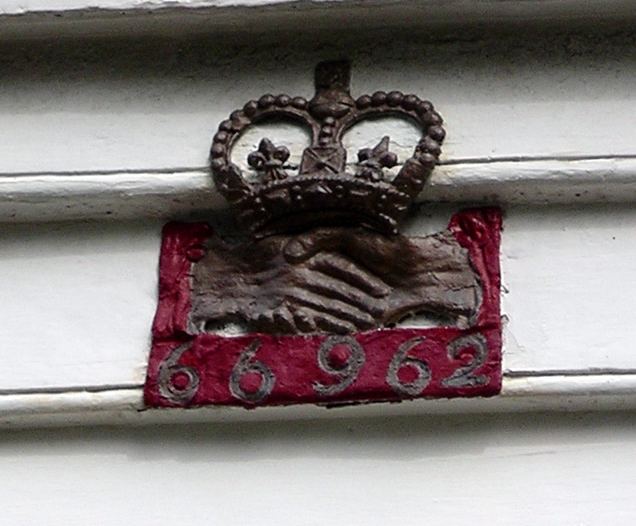 | ||
Fire insurance marks were metal plaques marked with the emblem of the insurance company which were affixed to the front of insured buildings as a guide to the insurance company's fire brigade. These identification marks were used in the eighteenth and nineteenth century in the days before municipal fire services were formed. The UK marks are called 'Fire insurance plaques'. The first to use the mark was the Sun Fire Office which was established in 1710. Some period specimens remain on historical buildings in the older areas of Britain's and America's cities and larger towns. Cast metal plaques were made of iron, lead, or sometimes brass. Embossed sheet metal signs were also made, as well as flat enamel signs – the latter mostly in Continental Europe in the later 19th century. Period specimens may have high value among antiques collectors, leading to illicit creation of fakes. Also, nostalgic reproductions have been made since the early 20th century for decorative purposes.
Contents
British fire marks
For most of the 18th century, each insurance company maintained its own fire brigade, which extinguished fires in those buildings insured by the company and, in return for a fee to be paid later, in buildings insured by other companies. By 1825, fire marks served more as advertisements than as useful identifying marks; some insurance companies no longer issued fire marks, and those that did sometimes left them up after a policy had expired. Successive combinations of fire brigades led to virtually the entire city of London being put under the protection of the London Fire Engine Establishment, which fought not only the fires of policy holders but those of nonsubscribers, the reason being that fires in uninsured buildings could rapidly spread to insured buildings.
American fire marks
Fire Insurance has over 200 years of history in America. The early fire marks of Benjamin Franklin's time can still be seen on some Philadelphia buildings as well as in other older American cities. Subscribers paid fire fighting companies in advance for fire protection and in exchange would receive a fire mark to attach to their building. The payments for the fire marks supported the fire fighting companies. Volunteer fire departments were also common in the United States, and some fire insurers contributed money to these departments and awarded bonuses to the first fire engine arriving at the scene of a fire.
Australian fire marks
Fire insurance companies began operating in the Australian colonies in the early part of the 19th century. They were both Australian and foreign, principally British, owned. The Union Assurance Company of Sydney and The Australasian Fire and Life Assurance Company are both recorded as having offices in George Street, Sydney in 1836. The Collingwood Fire Insurance Company (with a paid up capital of 200 000 pounds) was operating in Gertude Street, Collingwood, Victoria in 1854.
Fire brigades in metropolitan areas were organised much along the same lines as in the United Kingdom and the United States and were funded by the insurance companies. Likewise the companies issued fire marks to be affixed to buildings to indicate where there were risks for which they had underwritten policies. Such fire marks were commonly made of tinplate, cast iron and lead.
At least one company, the Norwich Union, issued "fire marks" printed on calico for use in rural areas. They were to be fixed on hay ricks, corn stacks and shearing sheds on the theory that they would indicate to arsonists that the owner was insured and would not be out of pocket should the property be destroyed by fire.
One feature of the insurance company funding of fire brigades survives in some Australian states and territories in the 21st century in that the fire brigade services are principally funded by a "fire service levy" or tax applied to all property insurance policies issued within a state.
